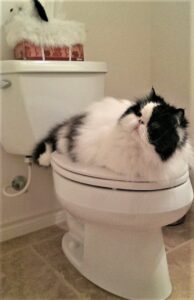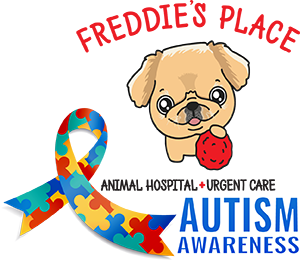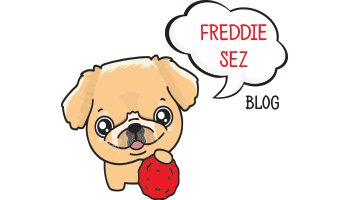 Freddie’s Tips for you on Potty Training your Pets
Freddie’s Tips for you on Potty Training your Pets
A couple years ago, when dogs were wolves & cats were living in the lap of luxury in Egypt, where your pet used the bathroom was pretty much already determined. Dogs went anywhere in the great outdoors with no limits, shaming from humans, or thought to the trouble they might be in if they had an accident. Cats lived in desert climates, so sand was everywhere. They could “pop a squat” where ever the mood, their legs, and desire, took them. The Pharaoh’s and their royal court didn’t care, there were slaves and serfs to handle anything that was dropped either on purpose or in the moment. Life was pretty simple.
Fast forward a few hundred, thousand, or whatever timeline you subscribe to in years, and the rules have changed quite a bit. Sure, wild animals still go freely in their habitats, feral cats and dogs follow no mans rules, but domesticated pets have a strict set of human made policy and rules. We all know the drill… Cats have litter boxes for indoors, and if the cat goes outdoor its a free for all… as long as their humans don’t see/smell/acquire by accident/step in the offending poo. Dog’s live a different sort of potty stress. They have transitioned into a mostly indoor life, so they have a couple options… signal the need to make a visit to their assigned “pooping field” and insist upon relief until someone caves and opens a door, use a designated “pee & poop” pad (and hope nothing gets astray from the 12”x12” drop zone), or hold the mess for the nightly walk and then watch there people pick it up, marvel at it, and then toss it in the trash. Dog’s have quite a gig… when they use the bathroom as they are trained, there is the obligatory praise and treats (which creates more poop. It’s an endless cycle… not unlike the circle of life, but with potty drops).
Let’s face it, we have become slaves to our pets and their excrement needs. Cats marvel at their power over humans, as they watch with glee as litter boxes are emptied, scrubbed, washed and refilled. Once the box meets the feline inspection, they happily, and immediately, jump in to toss litter around with an unbridled joy. Some cover, and cover, then cover again… theirs and anyone else s that might drop in. Others refuse to cover it so owners have to face the music and smell until the people cover it up for them. Don’t think they don’t know exactly what they are doing, it’s all part of the Cat World Domination Plan. They are working on the physiological inroads of human emotions with the end goal of driving us all crazy. So far, its working!
Dogs are a different type, as they mostly want to please. They are easily shamed, try hard to obey, and will hold their stuff until there is no other option left but to “drop the kids off on the rug.” If they have an accident, a dog will attempt to hand off blame to anyone, anything, or pretend it doesn’t exist… but when they are forced to face their mistake, they are immediately remorseful. A dog using the outdoors as their personal toilet will sometimes attempt to cover with a grass throwing, dirt digging, joy festival of raw emotion that is hilarious to watch. Others choose to drop and walk away, leaving secret poop bombs in awful locations that are hidden in plain sight. Day or night, no human is safe from these “Stealth Poops” and their precision dropping in clandestine locations… sitting in wait for a barefoot person, or someone on their way to an important event, the BOOM… the trap is sprung and someones foot or footwear in a scared & scarred victim. Most dogs feel badly after these landmines are uncovered… but there is a certain game “afoot”, so to speak.
So what’s a pet parent to do? Like the T-shirts and coffee mugs say “Poop Happens.” The real key is getting in front of the need, having a most efficient and timely plan to corral such droppings, and then insist the animals follow the directive and get into a routine. We all know its not foolproof, but with correction and praise, monitoring and assurance the designated areas are accessible and cleaned regularly, the majority of this nature driven task goes off like clockwork. Pooping can be fun for everyone involved… or at least not “un-fun.” All you need is to understand how your pet works, then make it easy for them to squat, drop, and repeat. And that is where our #FreddieSez team come into the picture. We’ve went out into the universe of the world wide web to find some tips on how to potty train your dogs and cats. We’ll share a few of our favorites for those who are struggling to “get Rover Regular”, or “Keep the Feline in Line.”
Let’s Talk about Dogs
Dogs have different classifications and categories when it comes to potty training. We’ll list the steps by age and/or maturity… as those are where the differences in your training techniques and the pets needs change.
Puppies
Dogs can be considered puppies for up to two years, but the key training time for young dogs is in their first 12 months. The earlier the training routine starts, the better they will accept the training and respond. It’s not hard to train a puppy if you’re diligent and keep to a schedule.
Adult Dogs
If you bring in a new “adult” dog (over two years old but not classified as a “Senior” animal), some of the steps to potty train are the same, but some are a bit different. You likely have no idea of their previous life, how they were trained, what the expectations were, or how they were treated, so go easy and be diligent. Training a new Adult Dog in your environment could be a bigger challenge.
The same rules of “routine, routine, routine”, the use of a crate as a calming force and their “property” or safe space is key. However, don’t make the cage a punishment… you don’t know how confinement was used in their previous life. Set that same type of schedule so they know what is expected and when. Just like a puppy, the older dog will adapt and likely love the structure of the routine. The use of a leash may not be needed, as older dogs may already have an understanding of a lead.
Senior Dogs
A senior dog is beyond the age of 8 years old in most breeds. The biggest difference in training a senior dog is their training understanding their needs, and how their age changes their routines. Seniors could have health issues slowing or limiting them. Accidents will happen more often because they simply don’t know the need is coming until its too late, and they can’t warn you or get to the door. If you find your senior is having accidents, here are a few tips to make their potty lives easier, and your mess cleaning lighter.
CATS
Kitten to older cat, the routine is easier… but your role is equal to or more important in training the felines. Here are a few quick tips on how to help your cat get used to their potty time environment.
It goes without saying that keeping your boxes scooped and filled is critical. If the box gets overloaded, the cat will go outside of it. That’s not them being bad, its them saying “that’s gross, dude… help a cat out”. Once they get the idea of a box and how that routine works, some owners have actually transitioned their cats to a “training box” that fits over the toilet. Once the cat understands an is trained, you remove the training box and the cat knows to us your toilet for their business. Sure, the line to use the bathroom is longer, but the overall mess is less. Lastly, your cat may prefer their litter box near their bed or food (that blow the “don’t poop where you eat” rule away… but cats are rebels).
That’s our review of potty training dogs and cats. We guess you could say it’s the “straight poop” we “dumped” on you! It’s our sincere hope that these tips will help you spend less time worrying about where and how they use the bathroom, and grown a more cohesive bond with your pets while teaching them the expectations and joy of potty time
As we look forward to this New Year, our wish is that you’ll continue you join us weekly for our Dog Blog. Till we meet again next week, please remember to be safe, be kind to each other, enjoy the time you have with family and friends, and above all else… be Pet Friendly, #FreddieSez.





Leave A Comment